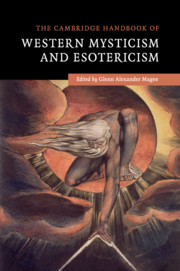Book contents
- Frontmatter
- Dedication
- Contents
- Acknowledgments
- Editor's Introduction
- List of contributors
- I ANTIQUITY
- II THE MIDDLE AGES
- III THE RENAISSANCE AND EARLY MODERNITY
- 12 Renaissance Hermetism
- 13 Christian Kabbalah
- 14 Paracelsianism
- 15 Rosicrucianism
- 16 Jacob Boehme and Christian Theosophy
- 17 Freemasonry
- 18 Swedenborg and Swedenborgianism
- 19 Mesmer and Animal Magnetism
- IV THE NINETEENTH CENTURY AND BEYOND
- V COMMON THREADS
- Suggestions for Further Reading
- Index
- References
19 - Mesmer and Animal Magnetism
from III - THE RENAISSANCE AND EARLY MODERNITY
Published online by Cambridge University Press: 05 May 2016
- Frontmatter
- Dedication
- Contents
- Acknowledgments
- Editor's Introduction
- List of contributors
- I ANTIQUITY
- II THE MIDDLE AGES
- III THE RENAISSANCE AND EARLY MODERNITY
- 12 Renaissance Hermetism
- 13 Christian Kabbalah
- 14 Paracelsianism
- 15 Rosicrucianism
- 16 Jacob Boehme and Christian Theosophy
- 17 Freemasonry
- 18 Swedenborg and Swedenborgianism
- 19 Mesmer and Animal Magnetism
- IV THE NINETEENTH CENTURY AND BEYOND
- V COMMON THREADS
- Suggestions for Further Reading
- Index
- References
Summary
Discovery of Animal Magnetism
In the last quarter of the eighteenth century, Franz Anton Mesmer (1734–1815) devised and promoted a healing method that he called “animal magnetism.” For approximately seventy-five years following its initial proclamation in 1779, animal magnetism flourished as a medical and psychological specialty, and for another fifty years it continued to be a system of influence, having a profound impact on medicine, psychology, and psychical research.
The seeds of thought that gave rise to animal magnetism are found in Mesmer's 1766 thesis Dissertatio physico-medica de planetarum influxu, which he wrote for his doctorate in medicine at the University of Vienna. Although he chose the title “Physical-medical Dissertation on the Influence of the Planets,” Mesmer was not interested in the occult and attempted to develop a theory of human health based on what he believed were purely physical, scientifically observable factors. Here he expounded his belief that just as there are tides in the ocean, so must there be tides in the human organism caused by the celestial bodies. He called this generalized influence “animal gravity.” Noting what he considered to be a similarity between gravity and magnetism, Mesmer attempted to cure the sick through the application of iron magnets. Using the terminology of the day, he called the carrier of magnetic influence “magnetic fluid,” which he believed was the foundation of life itself and the principle by which organic bodies carry out their vital functions. He asserted that the inhibition of this vital force produced disease. Mesmer therefore developed a technique to remove obstructions to the free flow of magnetic fluid in the body. After a period of experimentation in which he used mineral magnets to dissolve the blocks, he became convinced that the “magnet” of choice in healing is the physician's own body, which is capable of channeling the invisible fluid pervading the universe into the patient's body. This constituted his theory of “animal magnetism.”
Mesmer began his healing practice in Vienna, but after coming into conflict with both the medical establishment of that city and the family of one of his patients, he moved to Paris in 1778. There he gave his theory its first complete formulation, set up two clinics, and attempted to gain acceptance for his ideas from the local medical authorities.
- Type
- Chapter
- Information
- The Cambridge Handbook of Western Mysticism and Esotericism , pp. 223 - 234Publisher: Cambridge University PressPrint publication year: 2016

